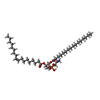+ Open data
Open data
- Basic information
Basic information
| Entry | Database: PDB / ID: 6uw4 | ||||||
|---|---|---|---|---|---|---|---|
| Title | Cryo-EM structure of human TRPV3 determined in lipid nanodisc | ||||||
 Components Components | Transient receptor potential cation channel subfamily V member 3 | ||||||
 Keywords Keywords | MEMBRANE PROTEIN / ion channel / TRPV3 | ||||||
| Function / homology |  Function and homology information Function and homology informationnegative regulation of hair cycle / osmosensory signaling pathway / response to temperature stimulus / TRP channels / positive regulation of calcium ion import / sodium channel activity / calcium ion import across plasma membrane / actin filament organization / calcium ion transmembrane transport / calcium channel activity ...negative regulation of hair cycle / osmosensory signaling pathway / response to temperature stimulus / TRP channels / positive regulation of calcium ion import / sodium channel activity / calcium ion import across plasma membrane / actin filament organization / calcium ion transmembrane transport / calcium channel activity / lysosome / receptor complex / cilium / metal ion binding / identical protein binding / plasma membrane / cytoplasm Similarity search - Function | ||||||
| Biological species |  Homo sapiens (human) Homo sapiens (human) | ||||||
| Method | ELECTRON MICROSCOPY / single particle reconstruction / cryo EM / Resolution: 3.1 Å | ||||||
 Authors Authors | Deng, Z. / Yuan, P. | ||||||
| Funding support |  United States, 1items United States, 1items
| ||||||
 Citation Citation |  Journal: Nat Struct Mol Biol / Year: 2020 Journal: Nat Struct Mol Biol / Year: 2020Title: Gating of human TRPV3 in a lipid bilayer. Authors: Zengqin Deng / Grigory Maksaev / Michael Rau / Zili Xie / Hongzhen Hu / James A J Fitzpatrick / Peng Yuan /  Abstract: The transient receptor potential cation channel subfamily V member 3 (TRPV3) channel plays a critical role in skin physiology, and mutations in TRPV3 result in the development of a congenital skin ...The transient receptor potential cation channel subfamily V member 3 (TRPV3) channel plays a critical role in skin physiology, and mutations in TRPV3 result in the development of a congenital skin disorder, Olmsted syndrome. Here we describe multiple cryo-electron microscopy structures of human TRPV3 reconstituted into lipid nanodiscs, representing distinct functional states during the gating cycle. The ligand-free, closed conformation reveals well-ordered lipids interacting with the channel and two physical constrictions along the ion-conduction pore involving both the extracellular selectivity filter and intracellular helix bundle crossing. Both the selectivity filter and bundle crossing expand upon activation, accompanied by substantial structural rearrangements at the cytoplasmic intersubunit interface. Transition to the inactivated state involves a secondary structure change of the pore-lining helix, which contains a π-helical segment in the closed and open conformations, but becomes entirely α-helical upon inactivation. Together with electrophysiological characterization, structures of TRPV3 in a lipid membrane environment provide unique insights into channel activation and inactivation mechanisms. | ||||||
| History |
|
- Structure visualization
Structure visualization
| Movie |
 Movie viewer Movie viewer |
|---|---|
| Structure viewer | Molecule:  Molmil Molmil Jmol/JSmol Jmol/JSmol |
- Downloads & links
Downloads & links
- Download
Download
| PDBx/mmCIF format |  6uw4.cif.gz 6uw4.cif.gz | 445.9 KB | Display |  PDBx/mmCIF format PDBx/mmCIF format |
|---|---|---|---|---|
| PDB format |  pdb6uw4.ent.gz pdb6uw4.ent.gz | 367.1 KB | Display |  PDB format PDB format |
| PDBx/mmJSON format |  6uw4.json.gz 6uw4.json.gz | Tree view |  PDBx/mmJSON format PDBx/mmJSON format | |
| Others |  Other downloads Other downloads |
-Validation report
| Summary document |  6uw4_validation.pdf.gz 6uw4_validation.pdf.gz | 1.6 MB | Display |  wwPDB validaton report wwPDB validaton report |
|---|---|---|---|---|
| Full document |  6uw4_full_validation.pdf.gz 6uw4_full_validation.pdf.gz | 1.6 MB | Display | |
| Data in XML |  6uw4_validation.xml.gz 6uw4_validation.xml.gz | 70.2 KB | Display | |
| Data in CIF |  6uw4_validation.cif.gz 6uw4_validation.cif.gz | 101.6 KB | Display | |
| Arichive directory |  https://data.pdbj.org/pub/pdb/validation_reports/uw/6uw4 https://data.pdbj.org/pub/pdb/validation_reports/uw/6uw4 ftp://data.pdbj.org/pub/pdb/validation_reports/uw/6uw4 ftp://data.pdbj.org/pub/pdb/validation_reports/uw/6uw4 | HTTPS FTP |
-Related structure data
| Related structure data |  20917MC  6uw6C  6uw8C  6uw9C M: map data used to model this data C: citing same article ( |
|---|---|
| Similar structure data |
- Links
Links
- Assembly
Assembly
| Deposited unit | 
|
|---|---|
| 1 |
|
- Components
Components
| #1: Protein | Mass: 90728.789 Da / Num. of mol.: 4 Source method: isolated from a genetically manipulated source Source: (gene. exp.)  Homo sapiens (human) / Gene: TRPV3 / Production host: Homo sapiens (human) / Gene: TRPV3 / Production host:  Komagataella pastoris (fungus) / References: UniProt: Q8NET8 Komagataella pastoris (fungus) / References: UniProt: Q8NET8#2: Chemical | ChemComp-6OU / [( #3: Chemical | ChemComp-NA / | Has ligand of interest | Y | |
|---|
-Experimental details
-Experiment
| Experiment | Method: ELECTRON MICROSCOPY |
|---|---|
| EM experiment | Aggregation state: PARTICLE / 3D reconstruction method: single particle reconstruction |
- Sample preparation
Sample preparation
| Component | Name: human TRPV3 / Type: COMPLEX / Entity ID: #1 / Source: RECOMBINANT |
|---|---|
| Source (natural) | Organism:  Homo sapiens (human) Homo sapiens (human) |
| Source (recombinant) | Organism:  Komagataella pastoris (fungus) Komagataella pastoris (fungus) |
| Buffer solution | pH: 8 |
| Specimen | Conc.: 1 mg/ml / Embedding applied: NO / Shadowing applied: NO / Staining applied: NO / Vitrification applied: YES |
| Vitrification | Cryogen name: ETHANE |
- Electron microscopy imaging
Electron microscopy imaging
| Experimental equipment |  Model: Titan Krios / Image courtesy: FEI Company |
|---|---|
| Microscopy | Model: FEI TITAN KRIOS |
| Electron gun | Electron source:  FIELD EMISSION GUN / Accelerating voltage: 300 kV / Illumination mode: OTHER FIELD EMISSION GUN / Accelerating voltage: 300 kV / Illumination mode: OTHER |
| Electron lens | Mode: OTHER |
| Image recording | Electron dose: 62 e/Å2 / Film or detector model: GATAN K2 SUMMIT (4k x 4k) |
- Processing
Processing
| CTF correction | Type: PHASE FLIPPING AND AMPLITUDE CORRECTION |
|---|---|
| 3D reconstruction | Resolution: 3.1 Å / Resolution method: FSC 0.143 CUT-OFF / Num. of particles: 70711 / Symmetry type: POINT |
 Movie
Movie Controller
Controller






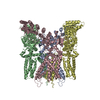

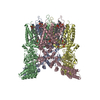

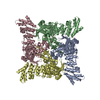

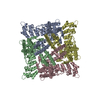


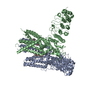
 PDBj
PDBj

